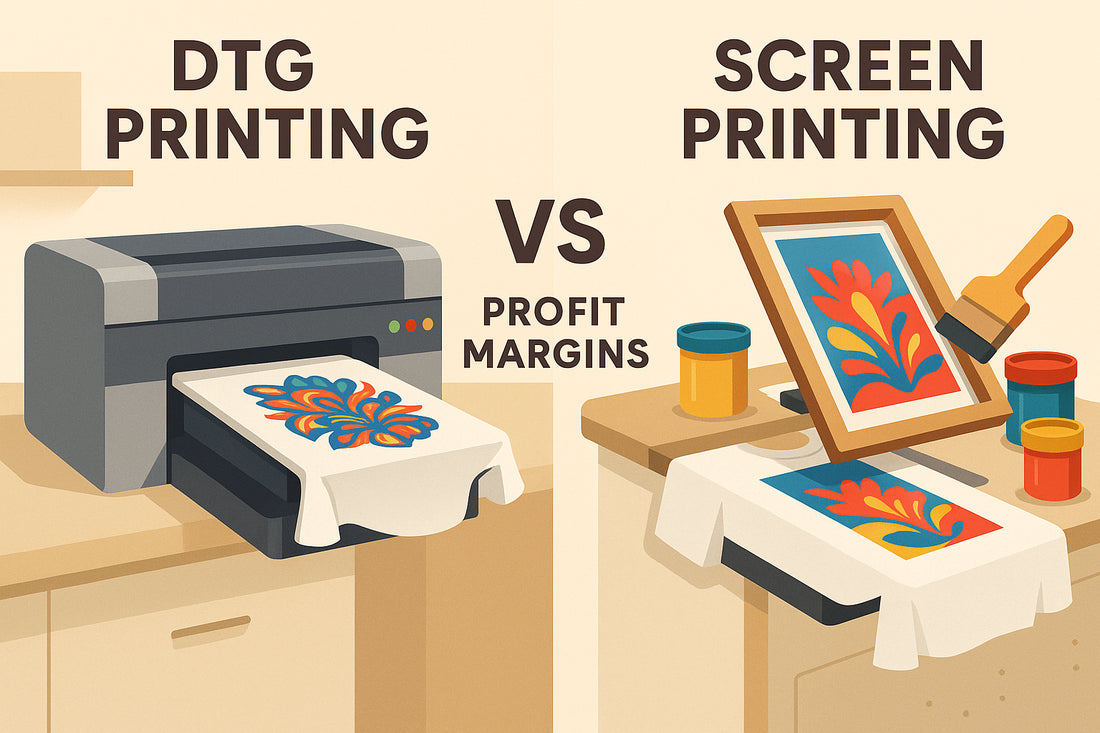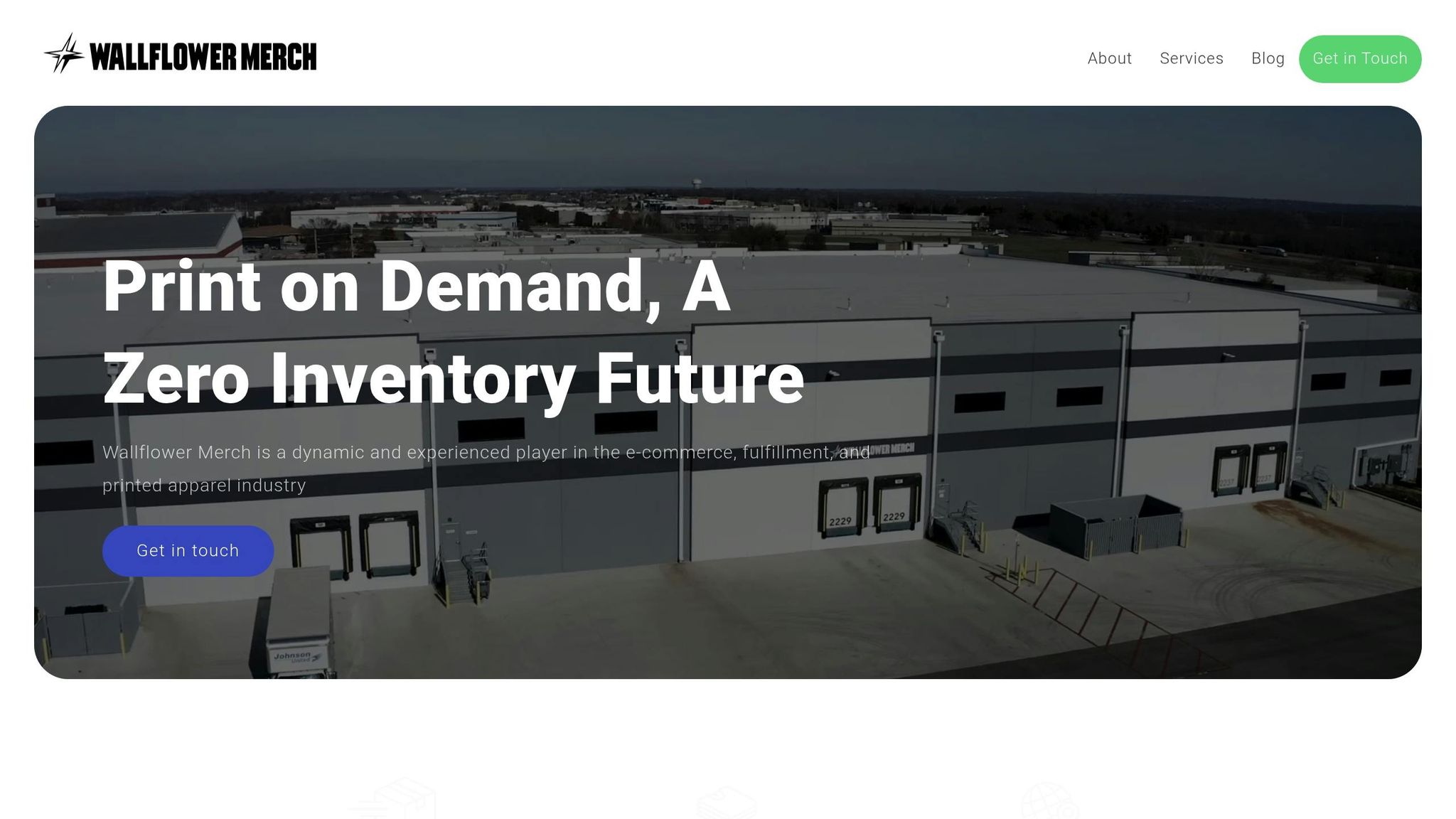
DTG Printing vs Screen Printing: Profit Margins
Share
DTG vs. Screen Printing: Which is More Profitable?
If you're deciding between DTG (Direct-to-Garment) and screen printing for your business, here's the quick answer:
- DTG Printing is best for small, customized, or on-demand orders. It has low setup costs, supports personalized designs, and avoids inventory risks.
- Screen Printing is ideal for large-volume orders. It offers lower per-unit costs for bulk production but comes with higher setup expenses.
Key Comparison:
| Factor | DTG Printing | Screen Printing |
|---|---|---|
| Setup Cost | Minimal | $50–$200 per design |
| Best Volume | 1–50 items | 200+ items |
| Customization | High | Limited |
| Inventory Risk | Low | Higher |
| Equipment Cost | $15,000–$30,000 | $2,000–$5,000 |
Choose DTG for flexibility and small orders. Opt for screen printing when producing in bulk to maximize profit margins. Both methods suit different business needs, so align your choice with your order volume and goals.
DTG vs. Screen Printing | Pros, Cons, How Much It Costs
Profit Margins Explained
Understanding how DTG (Direct-to-Garment) and screen printing handle costs can help you pinpoint which method works best for your business. DTG is ideal for smaller, customized orders, while screen printing offers lower per-unit costs for bulk production.
DTG Printing: Profits on Small Orders
With low setup costs and the ability to print on demand, DTG printing delivers solid profit margins for single-item orders. Its technology makes it possible to handle thousands of unique designs daily. For example, Wallflower Merch processes over 5,000 prints every day, proving how scalable and consistent DTG printing can be. On the other hand, screen printing is better suited for bulk orders, as its costs decrease with higher volumes.
Screen Printing: Profits on Bulk Orders
Screen printing becomes more profitable when working with larger quantities. Though the upfront costs are higher - due to the creation of screens and separating colors - the per-unit cost drops significantly as order sizes increase. This method is especially cost-efficient for orders of 50 or more pieces with the same design.
Comparing Margins
The table below highlights how profit margins differ between DTG and screen printing:
| Order Type | DTG Printing | Screen Printing |
|---|---|---|
| Single Item | High margin, low setup costs | Not cost-effective |
| 10-50 Items | Moderate margins, steady pricing | Lower margins due to setup costs |
| 50+ Items | Stable margins, higher per-unit cost | Higher margins with larger volumes |
| Custom Orders | Potential for premium pricing | Limited customization options |
Wallflower Merch's success - shipping over 1 million orders globally - demonstrates the profitability of digital printing. DTG's ability to adapt quickly to changing market demands allows brands to maximize earnings without taking on unnecessary risks or inventory.
Growth and Cost Analysis
DTG Printing: Handling Variable Orders
When it comes to managing fluctuating order sizes, DTG printing stands out. Its ability to handle changes in production volume without extensive setup time makes it a great option for businesses with inconsistent order demands. This method supports quick adjustments while delivering consistent quality, no matter the order size.
Screen Printing: Economies of Scale
Screen printing shines when dealing with large orders. While the setup costs are fixed for each design, the cost per unit decreases as the order size increases. This makes it a practical choice for brands focused on high-volume production, where the initial setup costs are balanced by lower costs per item.
Comparing Growth and Costs
DTG and screen printing cater to different business needs. DTG is ideal for flexible, smaller runs, while screen printing is better suited for large-scale production due to its cost efficiency at scale.
"Wallflower's advanced digital printing technology allows our clients to print one t-shirt or thousands. Orders can be shipped in bulk to one location or to individual customers all over the world."
These factors help businesses choose the printing method that best fits their production scale and growth plans.
sbb-itb-121f3a0
Starting Costs and Running Expenses
DTG Equipment and Expenses
DTG printers come with a price tag ranging from $15,000 to $30,000. One advantage of this method is that it avoids frequent setup fees tied to each design, helping reduce ongoing expenses.
Screen Printing Setup and Costs
Screen printing equipment is more affordable upfront, costing $2,000 to $5,000. However, this approach involves additional setup costs for each design, which can add up over time.
Cost Breakdown
Here's a quick comparison of the costs involved in both methods:
| Cost Category | DTG Printing | Screen Printing |
|---|---|---|
| Initial Equipment | $15,000–$30,000 | $2,000–$5,000 |
| Setup Cost per Design | Minimal | Higher |
Choosing the Right Method for Your Brand
The printing method you choose can directly affect your business's profitability and efficiency. Here's a breakdown to help you decide what works best for your needs.
DTG for E-commerce Brands
Direct-to-Garment (DTG) printing is a great option for e-commerce businesses looking to reduce inventory risks. This method works well if your brand:
- Tests new designs without needing upfront investments
- Requires fast turnaround times
- Offers personalized or custom products
DTG is ideal for brands wanting to avoid the hassle of managing large inventories. However, for businesses with consistently high-volume orders, another method might be more suitable.
Screen Printing for Large Runs
Screen printing is the go-to method for large orders. It’s particularly beneficial for brands that:
- Consistently produce high volumes of the same design
- Have established bestsellers
- Can accurately predict demand for specific designs
- Want to achieve the lowest per-unit costs at scale
| Order Volume | Best Printing Method | Key Advantage |
|---|---|---|
| 1-50 items | DTG Printing | No setup costs |
| 50-200 items | Either Method | Break-even point |
| 200+ items | Screen Printing | Lower unit cost |
Each method has its strengths and is tailored to different business models. Your decision should align with your production scale and goals.
Wallflower Merch Services

Wallflower Merch provides a streamlined solution for brands aiming to boost profit margins without dealing with inventory management. Their advanced digital printing system efficiently handles both individual and bulk orders.
Wallflower Merch is perfect for brands that:
- Want to scale their merchandise without investing in infrastructure
- Need a flexible production process
- Require design services and seamless e-commerce integration
- Prefer simplifying operations while maximizing profitability
The printing method you choose will significantly impact your costs and scalability, so consider your business needs carefully.
Summary
Choosing between DTG and screen printing comes down to understanding your order volume and business model. Here's a quick comparison to help you decide:
| Factor | DTG Printing | Screen Printing |
|---|---|---|
| Setup Cost | $0 | $50–$200 per design |
| Best Volume | 1–50 items | 200+ items |
| Inventory Risk | Low | Higher |
| Production Speed | Quick for small runs | Efficient for large runs |
DTG printing works well for small orders and personalized designs. On the other hand, screen printing becomes more cost-effective for larger batches, as the setup costs are spread across more units.
For businesses aiming to improve margins and simplify operations, print-on-demand services can be a game-changer. For example, Wallflower Merch uses an advanced M&R Polaris high-speed DTG system that has handled over 1 million orders in more than 100 countries. This system produces thousands of unique prints daily, helping businesses cut overhead costs and scale without investing in equipment or managing inventory.
Ultimately, the right choice depends on your business goals, with each method catering to different market demands and production volumes.
FAQs
What are the upfront costs of equipment for DTG printing versus screen printing, and how do these impact long-term profitability?
The initial investment for direct-to-garment (DTG) printing is typically higher than screen printing due to the advanced digital technology required for DTG machines. On the other hand, screen printing equipment generally has a lower upfront cost but involves additional expenses for setup materials like screens and inks for each design.
In terms of long-term profitability, DTG printing offers more flexibility with smaller runs and on-demand production, reducing inventory risks and waste. Screen printing, however, can be more cost-effective for large-volume orders due to lower per-unit costs at scale. Choosing the right method depends on your business model, order sizes, and scalability goals.
What should businesses consider when choosing between DTG and screen printing for custom or bulk orders?
When deciding between Direct-to-Garment (DTG) and screen printing, businesses should evaluate factors like order size, cost efficiency, and customization needs.
Screen printing is ideal for bulk orders because its setup costs are spread across larger quantities, resulting in a lower per-unit cost. However, it may not be cost-effective for smaller runs due to the upfront setup process. On the other hand, DTG printing is perfect for custom or small-batch orders, as it requires no setup and offers flexibility for intricate designs or one-off pieces.
For businesses looking to scale efficiently, DTG printing can also enable print-on-demand services, eliminating the need for inventory and upfront costs. This makes it a great option for brands seeking to monetize their designs without the risks of overproduction.
What are the inventory risks of DTG vs. screen printing, and how do they affect a business's strategy?
The inventory risks of direct-to-garment (DTG) printing and screen printing differ significantly, impacting how businesses plan their operations. DTG printing is typically used in a print-on-demand model, meaning there’s no need to hold large amounts of inventory. This reduces the risk of unsold stock and allows businesses to offer a wider variety of designs without upfront costs.
In contrast, screen printing often requires bulk production to be cost-effective, which can lead to higher inventory risks if certain designs or sizes don’t sell. Businesses using screen printing must carefully forecast demand to avoid overproduction and wasted resources.
For companies looking to scale efficiently or minimize financial risk, DTG’s flexibility and lower inventory requirements make it an appealing option for modern e-commerce strategies.
